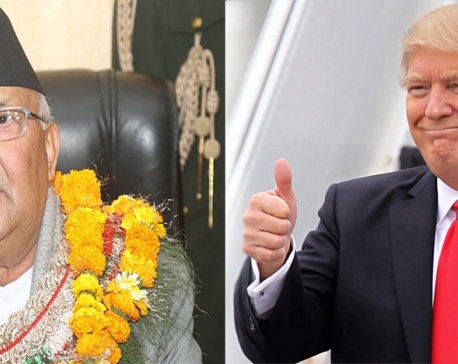
OR


Anna Marrs
The author is the CEO of Standard Chartered Bank’s ASEAN and South Asia regionnews@myrepublica.com
More from Author
The BRI can create a bigger network of markets and new opportunities for ASEAN and South Asia.
Two decades ago Asia was in the grip of a broad economic crisis. Through the 1998 Asian financial crisis, regional stock markets lost more than 60 percent of their value. Already fragile government reserves ran dry. By May 1998, Indonesia’s sovereign rating had fallen to CCC+.
This now seems a very long time ago. As 2017 draws to a close, let us reflect on the last two decades and envision what the next 20 years could be like. The recovery that followed the Asian financial crisis had been driven largely by domestic policy reforms, demographics in ASEAN and South Asia, and infrastructure investment in China.
Corrective measures and market-friendly policies by governments strengthened economic foundations. From 1997-2016, GDP per capita across ASEAN-6 countries had grown by 155 percent. Indonesia’s sovereign rating is now investment grade.
To sustain growth, economies need to be more connected than they are now. Not just within the national confines, but across borders too. For a region as diverse as ASEAN and South Asia, integration is hardly an easy process though. Within ASEAN alone, the difference between GDP per capita in Singapore and Cambodia is as big as 55 times.
There continues to be insufficient infrastructure, inconsistent regulations and trade barriers, and inadequate cybersecurity investments. These deficiencies limit the reach of supply chain networks and growth of the digital ecosystem.
The region is in dire need of infrastructure development. The Asian Development Bank (ADB) estimates that South Asia and Southeast Asia will need at least US $3.6 trillion from 2010 to 2020 in infrastructure investment to meet the needs of the growing populations in the two regions.
Countries are also more focused on building national digital payment systems and identity solutions than enabling cross-border points of connectivity.
Fundamental shift
To overcome these challenges, governments need to implement the right policies to encourage physical and digital buildouts that will spur flows of trade, investment, information, and people.
While regional countries recognize the importance of greater connectedness and have taken steps to bridge the infrastructure and digital gap, more can be done.
Over the next 20 years, the region’s economic transformation will be much more fundamental than the change seen over the last 20. Besides favorable demographics, we will see an unprecedented level of infrastructure investment. And not just the obvious infrastructure—bridges, railroads, ports. But, perhaps more excitingly, digital infrastructure. Demographic lift plus physical and digital infrastructure will catapult the region to a new level of productivity and prosperity—if the risks can be managed.
Firstly, physical infrastructure. On the back of China’s Belt and Road initiative, the region is planning to build—and starting to construct—at an unprecedented pace. It is estimated that US $4-8 trillion of cumulative infrastructure investment will flow on the back of BRI over the long term. Although ambition has been there historically, governments are now putting their money and actions where their mouths are. At a recent Philippines investment forum, the finance team set out plans to boost infrastructure investment from 3 percent to 7 percent of GDP within President Rodrigo Duterte’s term. When asked about implementation challenges, the Finance Minister quipped that delivery agencies needed to “use it or lose it—but which we mean not their budgets, but their jobs.”
Linked by the ancient Silk Road, the BRI can create a bigger network of markets and new opportunities for ASEAN and South Asia. Trade between Southeast Asia and South Asia grew from US $4 billion in 1990 to US $90 billion in 2013. In the same period, Southeast Asia’s share of South Asian trade rose from 6 percent to 10 percent, while South Asia’s portion of Southeast Asian trade doubled to 4 percent. This modest trend suggests that there’s room for growth.
A click away
Secondly, digital infrastructure. When India announced Aadhaar in 2009, few understood that digital identities were clearly the first step in digitizing economies. Today, with over 1 billion Indians with Aadhaar digital identities, India has been able to move the unbanked into the banking system en masse, and then digitize payments in one big leap on the back of demonetization. Other governments have been sending teams to India to study this transformation, believing economic efficiencies and higher tax takes on the back of greater transparency will quickly follow.
If executed right, these efforts will truly connect ASEAN and South Asia by 2037. From manufacturing to payments to delivery, the supply chain will be only a click away. This connectivity will decrease inefficiencies and ultimately cement two decades of strong growth.
But first, risks need to be managed. National tensions—most clearly on the back of BRI between India and China—exist. The ability to move seamlessly across digital and physical spaces can also create security challenges, of both the real and cyber varieties.
Greater competition may ensue too. In the years to 2037, the well-traveled economic development path for emerging markets that once relied on competitive labor costs to thrive will be challenged by innovative technology.
Despite these risks, the rewards will be worth it. Companies positioned to capitalize on the infrastructure and digital booms will thrive. And the economic growth that follows will lift both individuals and countries to new levels of prosperity. Over the past 20 years, the region has gone from crisis to growth hot spot. In the coming two decades, the growth hot spots will connect, creating a brighter and more sustainable future across the region.
The author is the CEO of Standard Chartered Bank’s ASEAN and South Asia region
You May Like This

Trump willing to partner with Oli to promote stability, governance and growth
KATHMANDU, Feb 23 : The US President Donald J. Trump has congratulated KP Sharma Oli on his election as the Prime... Read More...

Quality improvement in country's economy: growth estimated to be seven per cent
KATHMANDU, May 28: The Government has estimated the economic growth of the current fiscal year to increase by 6.94 per... Read More...

Crime growth lowest in decade: IGP Aryal
KATHMANDU, Oct 7: Even as financial and cyber crime rates have been rapidly increasing in the recent years, the number of... Read More...





Just In
- CM Kandel requests Finance Minister Pun to put Karnali province in priority in upcoming budget
- Australia reduces TR visa age limit and duration as it implements stricter regulations for foreign students
- Govt aims to surpass Rs 10 trillion GDP mark in next five years
- Govt appoints 77 Liaison Officers for mountain climbing management for spring season
- EC decides to permit public vehicles to operate freely on day of by-election
- Fugitive arrested after 26 years
- Indian Potash Ltd secures contract to bring 30,000 tons of urea within 107 days
- CAN adds four players to squad for T20 series against West Indies 'A'













Leave A Comment